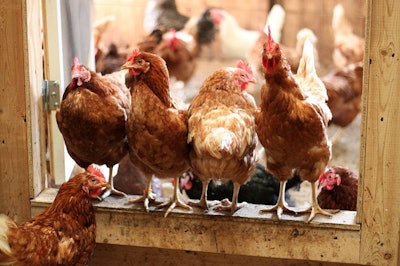
My previous blog post, “Navigating pet food product claims, part 1: scientific”, explained how the claims you make on your packaging are what make your product or brand unique. Additionally, we discussed the different types of scientific claims and the requirements for substantiating them. Lastly, we briefly discussed how making voluntary claims such as wholesome, natural, meat-first, grain-free or farm-to-table are no longer differentiating and are becoming commonplace in both pet specialty (premium brands) and the grocery channels (value brands).
So what’s next? No regulatory definition for humanely raised
In Debbie Phillips-Donaldson’s blog post, “Animal welfare meat: an up and coming pet food trend?”, she discussed the new trend of humanely raised animals being used in pet food as a differentiating point for premium products.
There is no regulatory definition for “humanely raised,” which makes evaluating these claims difficult. As a result, regulatory bodies look to independent, third-party auditors and certifications for substantiation. In general, a company’s claim must go through an auditing process every 12 to 15 months depending on which organization performs the audit and certification. For animals to be certified humane, they must meet or exceed a standard set of criteria that focus on animal welfare and husbandry. This includes all information from the day the animal was born until slaughter.
As a whole, many meat suppliers will not go through the extra steps for these types of certifications because these standards go above and beyond basic animal welfare practices. These standards include and are not limited to:
- How the animal was raised (i.e., pasture raised)
- Whether the animal was fed a healthy diet
- Whether it had access to fresh water all the time
- How the animal was slaughtered
To gain a better understanding of the different criteria, you can visit www.certifiedhumane.org or www.globalanimalpartnership.org for examples.
Other animal raising claims
Although there is no regulatory definition for humanely raised, there are other, more traditional animal raising claims including, and not limited to, grass fed, organic, raised without antibiotics or added hormones, free range, cage free and wild caught (i.e., fish). When making these claims, be prepared to have the proper documentation. Generally, regulatory agencies will be looking for signed affidavits from the producer, invoices proving you actually purchased the animal protein source and certifications if required (e.g., organic certified). This is to ensure you are not making false or misleading claims.
Pet food buyer beware
There is no doubt that animal raising claims are here to stay, especially when they are being used to support the cost of premium pet foods and treats. Unfortunately, the great marketers will imply humanely raised or superior ingredients with certain buzz words or terms that are meaningless or potentially misleading. As a result, I would be remiss if I didn’t point out some confusing or potentially misleading claims:
- Cage free does not mean that the animals have access to the outdoors or adequate spaces. They can be group housed in one building (i.e., open-concept barn) with insufficient or inadequate space (many poultry housed together).
- Farm raised does not mean that the animal you are sourcing is humanely raised or meets any other animal raising claims. Farm-raised chickens can live in cages, never see daylight and can be raised on factory farms.
- Farm-fed animals means exactly that: They were fed on a farm. Isn’t that true for all animals, whether it is a factory farm or small family farm?
- Farm fresh or fresh caught is not an indicator of better quality, nor is it an indicator of how the animal is raised. Have you ever caught a frozen tuna? Of course, it’s fresh caught!
- Organic can be an indicator of how the animals were raised or if they were humanely raised; however, there are loopholes. For example, the US Department of Agriculture (USDA) organic standard for livestock states, “For livestock such as cattle, sheep and goats, specify that they must have free access to certified organic pasture for the entire grazing season. This period is specific to the farm’s geographic climate, but must be at least 120 days. Due to weather, season or climate, the grazing season may or may not be continuous.” Additionally, the USDA standard states, “Outside the grazing season, ruminants must have free access to the outdoors year-round except under specified conditions (e.g., inclement weather).” This does not mean they have open access all the time, especially if you have harsh winters.
Humanely raised third-party certifications go above and beyond the USDA organic standards. Even though you may believe there are minor differences between the two, it can impact how the consumer perceives your product or if they buy it. When in doubt, ask if the animals are humane certified.
Humanely raised does not equal better nutrition
Lastly, it is important to point out that humanely raised is beneficial from an animal welfare standpoint only. Humanely raised animal protein sources does not mean that it provides better nutrition.
Next topic: “natural” product claims
Next time we will discuss, “Navigating through product claims, part 3: what does natural really mean?” Don’t worry, I will tackle organic and non-GMO in future blogs. If there are topics you would like to have discussed, feel free to comment below or reach out via LinkedIn: www.linkedin.com/in/ryanyamka.
Resources
Certified Humane. Date Accessed: November 9, 2017. www.certifiedhumane.org
Food Safety and Inspection Service. Date Accessed: November 9, 2017. https://www.fsis.usda.gov/wps/wcm/connect/6fe3cd56-6809-4239-b7a2-bccb82a30588/RaisingClaims.pdf?MOD=AJPERES
Global Animal Partnership. Date Accessed: November 9, 2017. www.globalanimalpartnership.org
USDA. Date Accessed: November 12, 2017. https://www.ams.usda.gov/sites/default/files/media/Organic%20Livestock%20Requirements.pdf



















